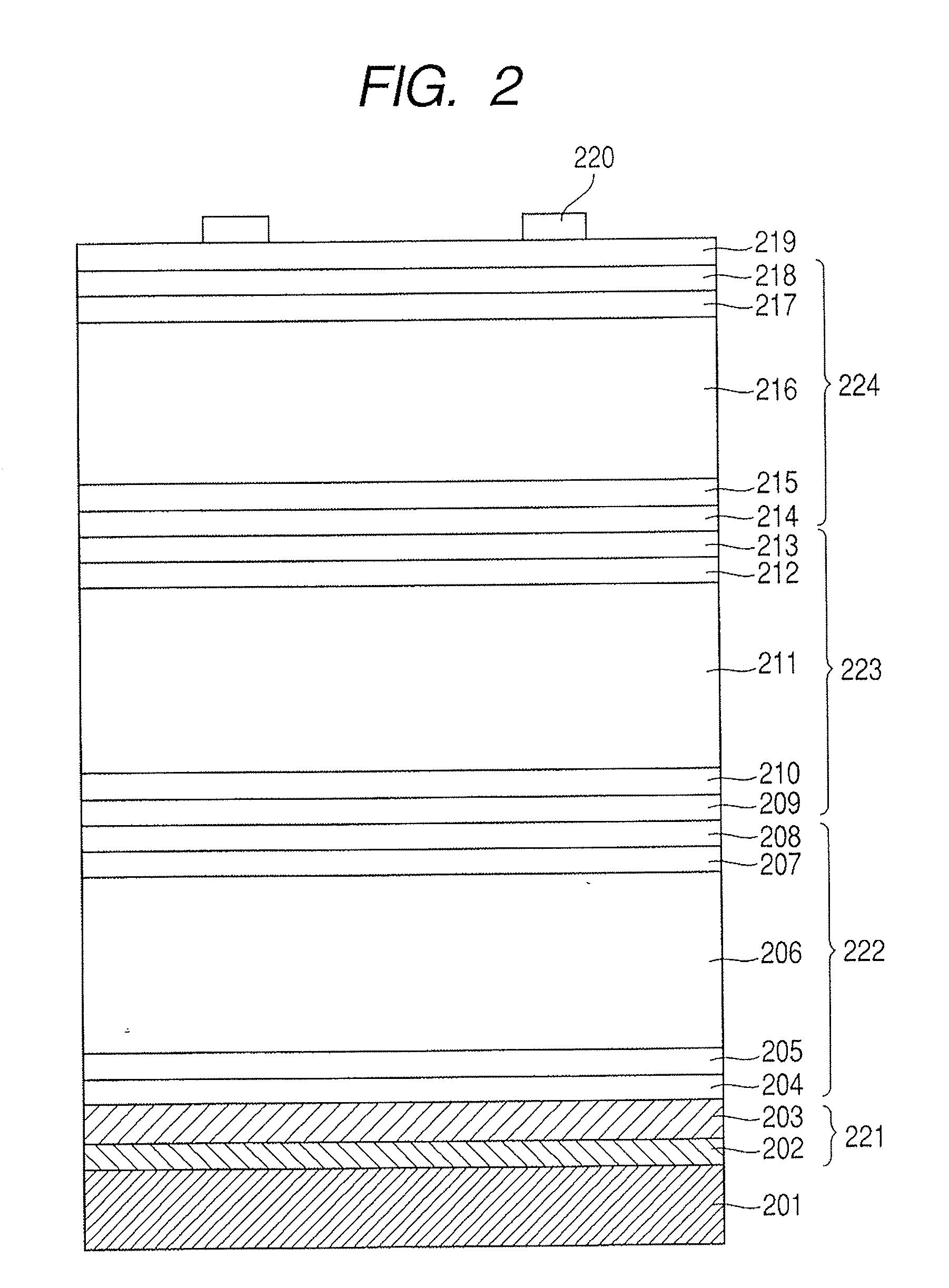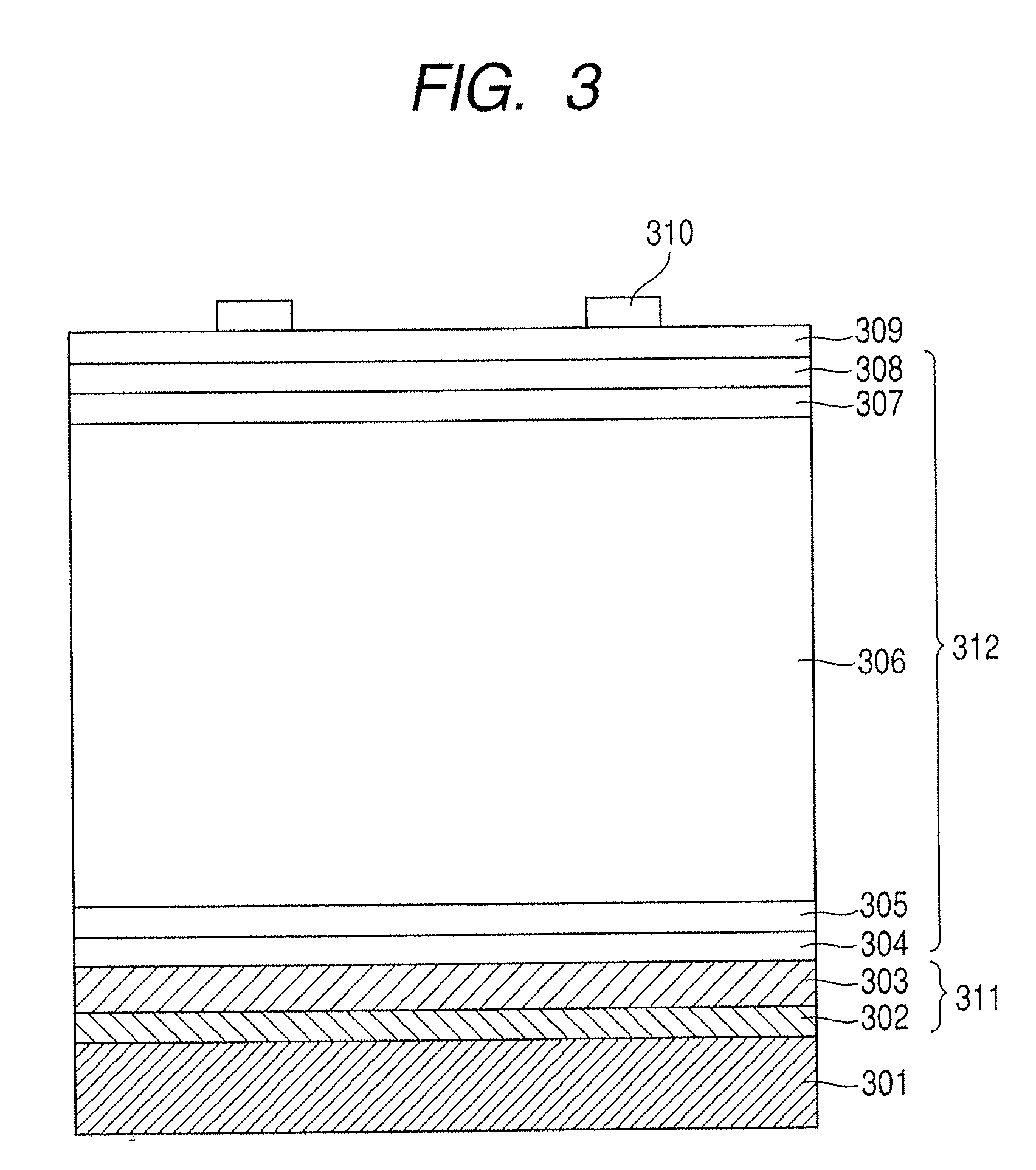Method of forming deposited film and method of forming photovoltaic element
a technology of photovoltaic elements and deposited films, which is applied in the direction of solid-state diffusion coatings, plasma techniques, coatings, etc., can solve the problems of large number of experiments, small open-circuit voltage values, and difficult to solve, so as to reduce the number of experiments, and improve the conversion efficiency
- Summary
- Abstract
- Description
- Claims
- Application Information
AI Technical Summary
Benefits of technology
Problems solved by technology
Method used
Image
Examples
example 1
[0181]A belt-shaped base member (40 cm in width, 200 m in length, and 0.125 mm in thickness) made of stainless steel (SUS430BA) was sufficiently degreased and cleaned, and then mounted to a continuous sputtering apparatus (not shown). An Ag thin film was vapor deposited in a thickness of 100 nm by sputtering using an Ag electrode as a target. Further, a ZnO thin film was vapor deposited in a thickness of 1.2 μm on the Ag thin film by sputtering using a ZnO target to thereby form a belt-shaped conductive substrate 501.
[0182]Then, the apparatus of the structure illustrated in FIG. 5 was used to deposit an n-type semiconductor layer, an i-type semiconductor layer, and a p-type semiconductor layer in sequence from the substrate side according to the above-mentioned procedure under the conditions in Table 1 with the pressure and the interelectrode distance during formation of the i-type layer being changed. After that, using a sputtering apparatus and a vapor deposition apparatus (not sh...
example 2
[0210]Samples of a solar cell (single cell) having a pin structure such as illustrated in FIG. 3 were made by following the same procedure as in Example 1 with the exception that the substrate temperature when the i-type layer was formed was changed as shown in the following Table 3.
TABLE 3n / ip / in-typebufferi-typebufferp-typelayerlayerlayerlayerlayerGas speciesand flow rateSiH4 (sccm)30155005050SiF4 (sccm)200H2 (slm)3.64100.415PH3 (%)5BF3 (%)30Bias voltage00−6000(V)Substrate temperature220250100 to220150(° C.)350Pressure10001000100010001000(Pa)High frequency power0.21.250.21.5(kW)(RF)(VHF)(VHF)(RF)(RF)Interelectrode distance101571510(mm)Film thickness2010200 / 1500105(nm)
[0211]The results are shown in Table 4 below. Incidentally, the item “region” in the characteristics of Table 4 is intended to mean classification of “amorphous region”, “microcrystalline region”, and “polysilane region” according to the results of the SEM observation and the RAMAN measurement of the formed samples.
TA...
example 3
[0216]Samples of a solar cell (single cell) having a pin structure such as illustrated in FIG. 3 were made by following the same procedure as in Example 1 with the exception that the bias voltage with respect to the interelectrode distance when the i-type layer was formed was changed as shown in Table 5 below.
TABLE 5n / ip / in-typebufferi-typebufferp-typelayerlayerlayerlayerlayerGas speciesand flow rateSiH4 (sccm)30155005050SiF4 (sccm)200H2 (slm)3.64100.415PH3 (%)5BF3 (%)30Bias voltage000 to00(V / cm)−400Substrate temperature220250190220150(° C.)Pressure10001000100010001000(Pa)High frequency power0.21.250.21.5(kW)(RF)(VHF)(VHF)(RF)(RF)Interelectrode101571510distance(mm)Film thickness (nm)2010200 / 1500105
[0217]The results are shown in Table 6 below. Incidentally, the item “region” in the characteristics of Table 6 is intended to mean classification of “amorphous region”, “microcrystalline region”, and “polysilane region” according to the results of the SEM observation and the RAMAN measure...
PUM
| Property | Measurement | Unit |
|---|---|---|
| Fraction | aaaaa | aaaaa |
| Temperature | aaaaa | aaaaa |
| Temperature | aaaaa | aaaaa |
Abstract
Description
Claims
Application Information
 Login to View More
Login to View More - R&D
- Intellectual Property
- Life Sciences
- Materials
- Tech Scout
- Unparalleled Data Quality
- Higher Quality Content
- 60% Fewer Hallucinations
Browse by: Latest US Patents, China's latest patents, Technical Efficacy Thesaurus, Application Domain, Technology Topic, Popular Technical Reports.
© 2025 PatSnap. All rights reserved.Legal|Privacy policy|Modern Slavery Act Transparency Statement|Sitemap|About US| Contact US: help@patsnap.com



